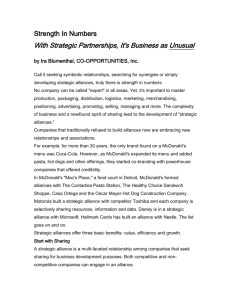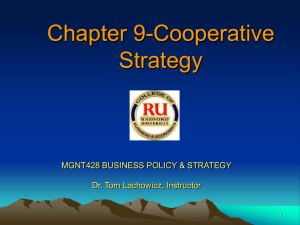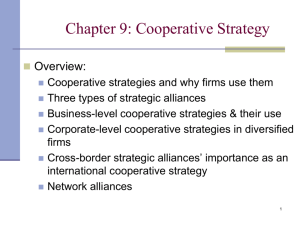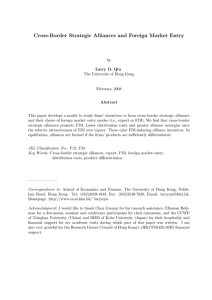Notes_1 - Pen Pacific
advertisement
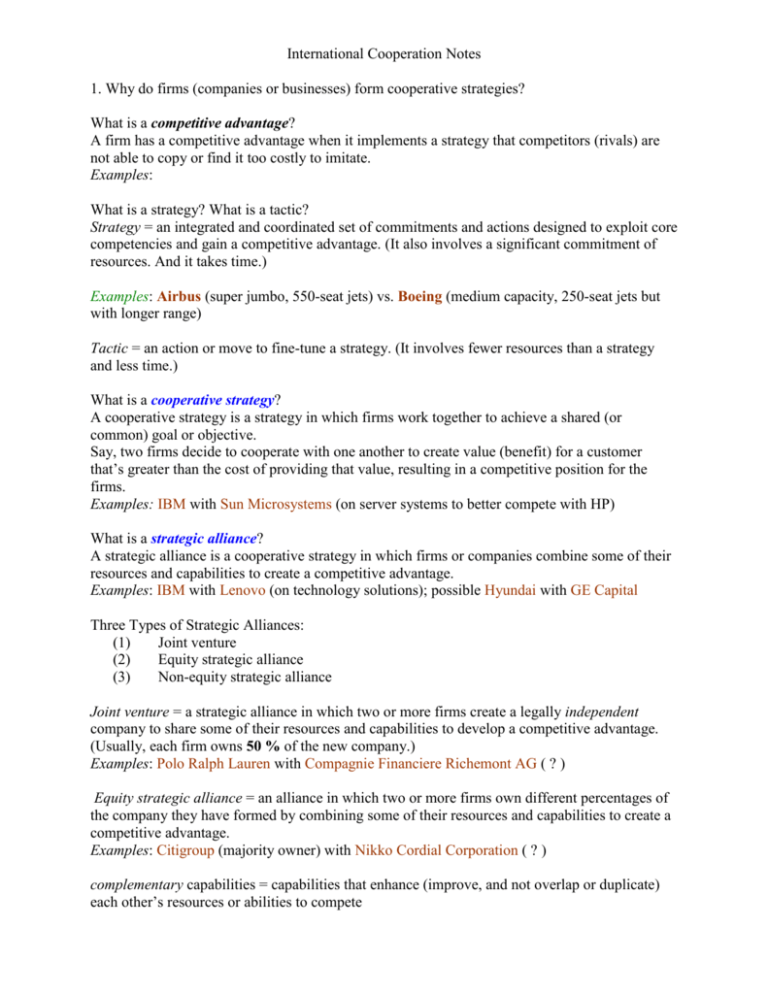
International Cooperation Notes 1. Why do firms (companies or businesses) form cooperative strategies? What is a competitive advantage? A firm has a competitive advantage when it implements a strategy that competitors (rivals) are not able to copy or find it too costly to imitate. Examples: What is a strategy? What is a tactic? Strategy = an integrated and coordinated set of commitments and actions designed to exploit core competencies and gain a competitive advantage. (It also involves a significant commitment of resources. And it takes time.) Examples: Airbus (super jumbo, 550-seat jets) vs. Boeing (medium capacity, 250-seat jets but with longer range) Tactic = an action or move to fine-tune a strategy. (It involves fewer resources than a strategy and less time.) What is a cooperative strategy? A cooperative strategy is a strategy in which firms work together to achieve a shared (or common) goal or objective. Say, two firms decide to cooperate with one another to create value (benefit) for a customer that’s greater than the cost of providing that value, resulting in a competitive position for the firms. Examples: IBM with Sun Microsystems (on server systems to better compete with HP) What is a strategic alliance? A strategic alliance is a cooperative strategy in which firms or companies combine some of their resources and capabilities to create a competitive advantage. Examples: IBM with Lenovo (on technology solutions); possible Hyundai with GE Capital Three Types of Strategic Alliances: (1) Joint venture (2) Equity strategic alliance (3) Non-equity strategic alliance Joint venture = a strategic alliance in which two or more firms create a legally independent company to share some of their resources and capabilities to develop a competitive advantage. (Usually, each firm owns 50 % of the new company.) Examples: Polo Ralph Lauren with Compagnie Financiere Richemont AG ( ? ) Equity strategic alliance = an alliance in which two or more firms own different percentages of the company they have formed by combining some of their resources and capabilities to create a competitive advantage. Examples: Citigroup (majority owner) with Nikko Cordial Corporation ( ? ) complementary capabilities = capabilities that enhance (improve, and not overlap or duplicate) each other’s resources or abilities to compete Non-equity strategic alliance = an alliance in which two or more firms develop a contractual relationship to share some of their unique resources and capabilities to create a competitive advantage. (The firms do not establish a separate independent company and therefore have no equity or ownership positions. Types: licensing agreements, distribution agreements, and supply contracts say, outsourcing agreements; Less formal, demands fewer commitments than joint ventures and equity strategic alliance.) Examples: Dell with Roadway Logistics System ( ? ) Reasons Firms Develop Strategic Alliances: (1) allows partners to create value that they couldn’t develop if acting on their own (2) allows firms to enter markets more quickly and with greater penetration possibilities (3) most firms lack enough resources and capabilities to reach their objectives Put another way, reasons include: - to reduce competition - enhance competitive capabilities - gain access to resources - take advantage of opportunities - build strategic flexibility - innovate How important are strategic alliances? In large firms, strategic alliances could account for 25 % or more of sales revenues. Alliance vs. alliance compared to firm vs. firm? Reasons for strategic alliances by market type: - slow cycle market: - fast-cycle market: - standard cycle market: Types of Cooperative Strategies: (1) Business-level cooperative strategy (2) Corporate-level cooperative strategy (3) International cooperative strategy (4) Network cooperative strategy










